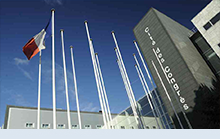 |
European Planetary Science Congress 2015
27 September – 02 October 2015
La Cité des Congrès, Nantes, France |
 |

|
AM1 Amateur and citizens collaborations in small bodies, terrestrial, giant and exo planets professional studies |
| Convener: Marc Delcroix | Co-Conveners: Christophe Pellier , Padma Yanamandra-Fisher , Felipe Braga-Ribas |
|
Oral Program
/ Thu, 01 Oct, 14:00–16:45
/ Room Mars
Poster Program
/ Attendance Thu, 01 Oct, 17:45–19:15
/ Poster Area
|
Amateur astronomy has evolved dramatically over recent years. A motivated amateur, with his/her backyard instrument and available processing software is nowadays capable of getting high-resolution planetary images in different wavelengths (better than many professional observatories could achieve 15 years ago), following stellar occultations by giant planets' atmospheres or their satellites' mutual phenomena, or doing high-precision photometry of exoplanet transits. Other committed amateurs use dedicated cameras or radio-antennae to provide continuous meteor-detection coverage of the sky near their location.
Hundreds of regular observers are sharing their work, providing a very good coverage of the main visible planets (Jupiter, Saturn, Mars and Venus) which is very valuable at a time when professional astronomers face increasing competition accessing resources, which often have to be shared with other areas of research. Additionally, these networks of amateur observers can react at very short notice when triggered by a new event occurring on a solar system object requiring observations.
Moreover, some advanced amateur astronomers use advanced methods for analyzing their data meeting the requirements of the modern researcher, thereby facilitating regular and close collaboration with professionals. Often this leads to publication of results in peer-reviewed scientific journals. Examples include planetary meteorology of Jupiter and Saturn; meteoroid or bolide impacts on Jupiter; asteroid, cometary or exoplanet research; studies of Venus.
Advances in technology, social media and big data, also gives way to citizen science with many applications.
This session will showcase results from citizen science and amateur astronomers, working either by themselves or in collaboration with members of the professional community. In addition, members from both communities will be invited to share their experiences of pro-am partnerships and offer suggestions on how these should evolve in the future.
